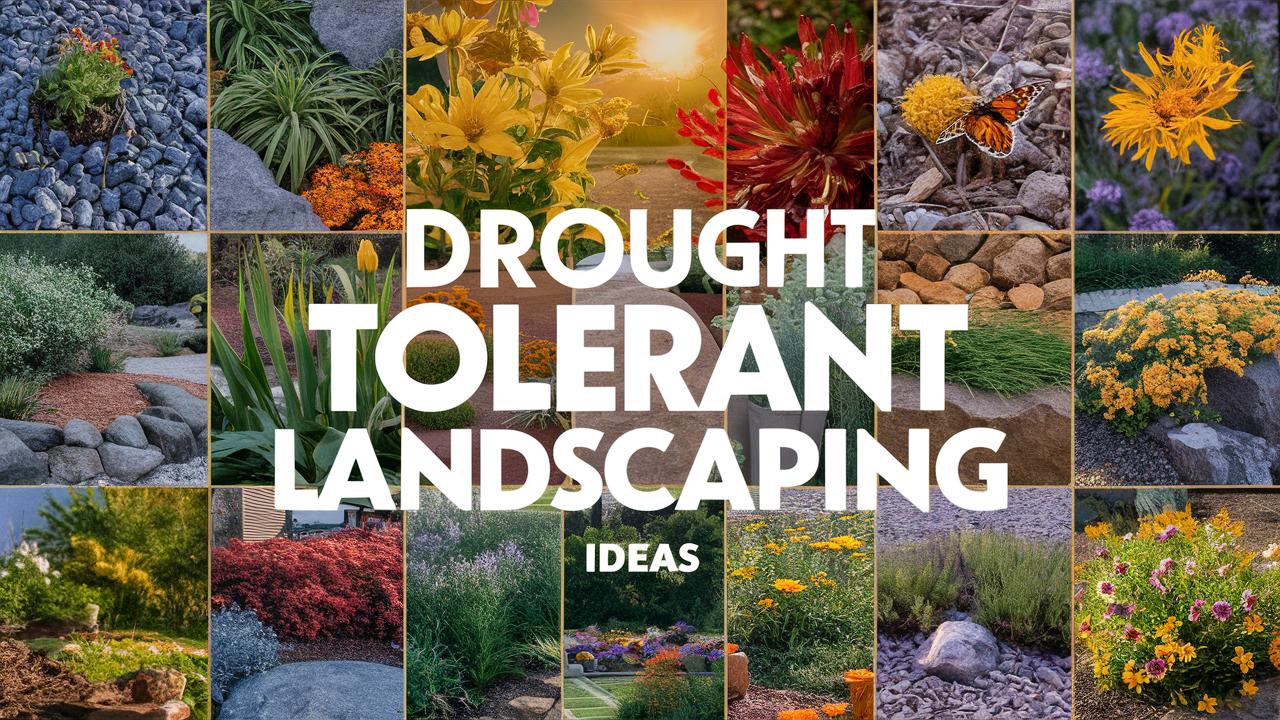This guide explores innovative and inspiring ideas for creating a drought-tolerant landscape, while still enhancing the beauty and functionality of your outdoor areas.
View this post on Instagram
I think this design is just so striking with its colorful groundcover and mix of textures. The various cactus add such a unique sculptural element, right? And how great does the contrasting gravel look? I bet you could recreate this look with your favorite colors and some local stone too! It is really just about getting creative and seeing the opportunity.
View this post on Instagram
Here’s one idea that really stood out to me. Imagine coming home to this burst of color every day! It’s got this amazing mix of textures and heights, with the flowers spilling over in the most charming way. And the best part? All those plants are drought-tolerant, so you get all the beauty without the guilt of wasting water. I especially love how they used the river rocks to add some visual interest and keep the moisture in the soil – it’s all so clever and gorgeous.
View this post on Instagram
I’m really digging this modern, clean look! The walkway is so inviting with those large pavers, and the gravel in between keeps it low-maintenance. I love how they’ve used different textures and heights with the plants, it adds depth and visual interest, it is a drought-tolerant design that looks lush but is surprisingly easy to care for. What a fantastic example of drought-friendly landscaping that still looks amazing!
View this post on Instagram
This design is all about textures and contrasting heights, which I think is so cool. The blue fescue grass adds such a soft, whimsical feel against the more structured succulents and low stone wall, don’t you think? The gravel ground cover is super practical and ties everything together nicely. I could totally see myself walking down that stone path every morning! Plus, those little landscape lights are a perfect finishing touch for a nighttime glow.
View this post on Instagram
This design is a great one. I am in love with the contrasting textures. The mix of pebbles, mulch, and varying plant heights adds so much visual interest, don’t you think? Using different succulents and drought-tolerant grasses really creates a dynamic and natural-looking space, not to mention those rocks. You can totally adapt something like this to fit any space, big or small!
View this post on Instagram
This design is one of my favorites, seriously! I love how it mixes different textures and shades of green with those bright succulents, it brings such life to the space. And look at the rocks! It’s like an art installation that just happens to be super low maintenance. Plus, those ornamental grasses add a softness that keeps it from feeling too harsh, don’t you think? If you wanted to add some color, you could dot in some flowering succulents too.
View this post on Instagram
Here’s a thought, how about terracing a sloped area? It looks so cool. The block walls create planting pockets for some drought-friendly shrubs and trees, and they’re pretty low-maintenance. I love the mix of textures with the gravel and the little patch of green lawn, too. And that Agapanthus! It’s so vibrant, It really makes the whole yard pop.
View this post on Instagram
Here’s one to check out, the textures are just amazing! I love how the dark gravel really makes the golden barrel cactus pop, it’s a simple design but the effect is stunning. And that funky cactus in the corner? Talk about a statement piece. It feels modern, clean, but still totally warm and inviting. Plus that minimal tree gives height without blocking the light.
View this post on Instagram
Now here is a garden that really pops! I absolutely love how the vibrant bougainvillea just cascades over the house, adding a touch of romance and major curb appeal. And the layers in the garden bed are so well done, with that soft ornamental grass next to the trimmed hedge. It’s proof you don’t need a ton of water to create something gorgeous and full of life. I think that kind of approach would be beautiful at my place and I am hoping you think so too.
View this post on Instagram
I really love this mix of textures and colors! Using different succulents really creates a lush, interesting garden. Plus, the little pops of yellow really make the other plants stand out. And how cute is that turtle statue tucked in there? It just adds a little bit of whimsy and personality, don’t you think?
View this post on Instagram
I really love how this design uses different textures and colors to create depth, and even the dark foliage looks incredible against the pink ground cover, so pretty! Using a raised bed like this also makes the landscaping feel very intentional and curated. If you want a little drama, I think this design would be perfect for you. It seems like a good way to create a focal point and it would be ideal for making a statement to passersby.
View this post on Instagram
This one just feels so welcoming, doesn’t it? The soft grasses against the rigid shapes of the succulents and boulders create a nice balance. And I love how the pops of color from the flowering ground cover liven it all up, that pink really stands out. Plus, imagine how the grasses sway in the breeze – so calming! The little lanterns along the walkway add a nice touch, too, I want to put them everywhere in my design.
View this post on Instagram
I think this little rock garden thing is so cute, don’t you? It’s the perfect way to add some visual interest to a small area, and requires practically zero watering which is great for the hot Summer. I really love the mix of textures from the ornamental grasses, the small shrubs and the rocks, it gives the space some depth and character. It’s amazing how a few well-placed boulders can really pull everything together. Plus, the pebbles are great for preventing weeds!
View this post on Instagram
Isn’t this a cool idea? I love how the long, sleek planter boxes give it such a modern vibe, and the mix of textures is just gorgeous. Those feathery grasses and the sculptural succulents play off each other so well. The dark pebbles as mulch are so smart – looks great and helps retain moisture! Plus, that horizontal fence in the background really pulls everything together, right?
View this post on Instagram
I’m really digging how this landscape uses rocks as a main feature, mixed with succulents in different colors. Imagine walking around with that textured ground cover, surrounded by the contrast of those spiky agaves and the softer, golden sedum. I love how the boulders add dimension and a sense of permanence, and the taller grasses and shrubs in the background create a cool, layered effect. It feels both structured and natural, and definitely gives off that chill, low-maintenance vibe. What a great choice!
View this post on Instagram
I really dig this desert modern vibe! The contrasting textures of the rounded cacti against the spiky ocotillo and the smooth walkway are really appealing. The different colored gravel and pebbles give it such a sophisticated and curated feel, while still feeling pretty minimal and easy to maintain. I also really like how the white fence gives it a cool, clean backdrop to the whole composition. It looks like a really chill space.
View this post on Instagram
I just love how this design uses various cacti and succulents for a truly unique and modern feel. The winding stone path provides a great focal point and a defined walkway between the plants. I think the muted sandy tones contrast so nicely with the vibrant greens and reds of the plants, plus the block wall in the background offers a nice backdrop. It really is a cool, low-maintenance option if you are looking for something a little different. It’s inspiring!
View this post on Instagram
I’m really digging how the different heights and textures play off each other in this design. The tall, slender cacti really pop against that bright white wall and those leafy plants add a cool contrast. The gravel ground cover is genius, super low-maintenance and really makes the plants the star of the show. Plus, that pop of green lawn just makes everything feel so fresh, even with the arid plants. It’s definitely giving me some bold ideas for my own yard!
View this post on Instagram
How about creating a scene with a desert vibe? I love the look of using different sized cacti and succulents mixed with rocks to give a natural, textured feel. The contrasting shapes and colors really pop, especially with the gravel ground cover. Imagine a landscape that’s both striking and super low maintenance!
View this post on Instagram
I think this design shows off some cool ways to play with texture in a dry climate. Look how those sculptural agaves are set against the round, spiky cacti and the tall ocotillo… it creates so much visual interest. Using dark gravel as mulch makes everything really pop. Plus, can you imagine how amazing this would look at sunset? And the best part is, once it’s established, it basically takes care of itself.
View this post on Instagram
I’m really digging the architectural lines with the desert feel! It’s got a modern vibe, right? The use of different textures, like the smooth stones and the spiky plants, is really appealing too. And I like how they kept it simple with the gravel ground cover, makes the plants really pop. Little pops of color that can handle the heat are always a plus.
Drought Tolerant Landscaping Ideas
Drought-tolerant landscaping is not only a practical solution for managing water scarcity but also an opportunity to create beautiful, sustainable outdoor spaces. As climate change leads to increasingly erratic weather patterns and persistent droughts, it becomes essential to rethink our gardening and landscaping strategies.
Understanding Drought-Tolerant Landscaping
Drought-tolerant landscaping encompasses the use of plants, hardscapes, and garden designs that minimize water usage. This approach promotes the selection of native and adapted species that thrive on natural rainfall and require less maintenance. Additionally, it incorporates techniques that enhance soil quality, reduce evaporation, and improve water retention.
Investing in drought-tolerant landscaping is a lifelong endeavor, providing ongoing environmental benefits. By choosing sustainable practices, you’re not just creating an aesthetically pleasing garden; you’re also contributing to your local ecosystem’s health and resilience.
Choosing the Right Plants
When it comes to drought-tolerant landscaping, plant selection is paramount. Native plants are generally the best choice, as they are adapted to the local climate and soil conditions. This familiarity means they require less water after establishment and attract local wildlife, like pollinators.
Look for succulents, cacti, and other drought-resistant species. Some popular options include:
Agave: This striking succulent comes in various sizes and colors, thriving in poor soil conditions while bringing a sculptural quality to the landscape.
Lavender: Not only does lavender provide a beautiful, fragrant backdrop, but it’s also drought-resistant and attracts beneficial insects.
California Poppy: This vibrant wildflower is ideal for adding splashes of color and is remarkably low-maintenance once established.
Sedums: Available in multiple varieties, sedums are hardy, able to withstand extreme conditions while offering beautiful foliage and flowers.
Incorporating these plants into your garden can yield a dynamic display without sacrificing water resources.
Grouping Plants by Water Needs
An effective strategy for drought-tolerant landscaping is to group plants according to their water requirements. This approach, known as hydrozoning, maximizes water efficiency and minimizes waste.
Create distinct zones within your landscape based on each group’s needs. For instance, locate high water-demand plants, such as certain vegetables or annuals, near water sources, while placing drought-tolerant plants in dry, sunny locations where they can thrive with minimal irrigation. By designing your landscape with hydrozoning in mind, you ensure that every plant receives the appropriate care without overwatering.
Incorporating Hardscapes
Hardscaping plays a significant role in drought-tolerant landscaping. Hardscapes are non-plant elements, such as paths, patios, and walls, that help define your outdoor space. Choosing the right hardscaping materials can enhance the overall aesthetic while reducing the need for water. Here are some ideas to consider:
Permeable Paving: Use permeable materials for driveways and walkways, allowing water to penetrate the surface and replenish groundwater while reducing runoff. Options include gravel, permeable pavers, or porous concrete.
Dry Riverbeds and Rock Gardens: These landscape features not only add visual interest but also facilitate drainage and water absorption, reducing soil erosion and encouraging native plants to thrive.
Retaining Walls: Built from natural stone or recycled materials, retaining walls can create visually appealing terraced gardens that manage water flow. These walls also provide habitats for various organisms, supporting biodiversity.
Outdoor Rooms: Consider creating outdoor living areas with shaded structures. Pergolas or gazebos can provide respite from the sun, enabling you to enjoy your gardens while minimizing water needs during peak heat.
By carefully considering how to incorporate hardscaping elements into your design, you can create a sustainable, beautiful outdoor environment.
Efficient Irrigation Methods
While drought-tolerant plants significantly reduce water needs, strategic irrigation is still essential during establishment and periods of extreme heat. Implementing efficient watering systems can help maintain plant health while conserving water:
Drip Irrigation: This method delivers water directly to the plant roots, minimizing loss through evaporation and runoff. A well-designed drip system can efficiently water multiple areas of the garden with precision.
Rain Barrels: Set up rain barrels to collect rainwater from your roof. This eco-friendly solution allows you to use natural precipitation to water your landscape, reducing dependence on municipal water sources.
Soaker Hoses: Placing soaker hoses beneath mulch helps water the soil evenly and slowly, preventing water wastage and promoting deep root growth.
Smart Timers and Sensors: If you have an automated irrigation system, consider incorporating smart timers or soil moisture sensors. These devices can adjust watering schedules based on current weather conditions, ensuring that water is only applied when necessary.
Incorporating advanced irrigation methods allows you to maintain the beauty of your landscape while utilizing resources wisely.
Mulching for Moisture Retention
Mulching is a critical step for maintaining a drought-tolerant landscape. It serves multiple purposes: suppressing weeds, regulating soil temperature, and enhancing moisture retention. Choose organic mulch, like wood chips, bark, or straw, for the best results. Here’s how to maximize its benefits:
Apply a Thick Layer: A mulch layer of three to four inches can significantly reduce evaporation rates while preventing weeds from competing for moisture.
Replenish Regularly: Organic mulch breaks down over time, so make it a routine to refresh the mulch layer at least once a year.
Avoid Mulching Against Plant Stems: Always keep mulch a few inches away from the base of plants. This prevents rot and creates better aeration.
By embracing the practice of mulching, you’ll help your garden conserve water, enhance soil health, and maintain a neat appearance.
Edible Drought-Tolerant Gardens
Incorporating edible plants in a drought-tolerant landscape is an exciting way to enjoy homegrown produce without excessive water use. Many fruits, vegetables, and herbs are native to arid regions or have drought-tolerant qualities. Consider these options:
Herbs: Basil, rosemary, thyme, and sage require minimal water and can thrive in well-drained soil, making them perfect for a drought-tolerant herb garden.
Vegetables: Crops like eggplant, peppers, and tomatoes are relatively drought-resistant. Plant them in groupings to enhance pollination, provide shade, and create an appealing visual presence.
Fruits: Low-water fruit trees, like pomegranates, figs, and olives, add unique flavors to your dishes while standing up to dry conditions.
Creating a drought-tolerant vegetable garden not only promotes sustainability but also encourages self-sufficiency and healthier eating habits.
Ground Cover Solutions
Ground covers are a fantastic addition to drought-tolerant landscapes. They provide aesthetic value while reducing soil erosion, suppressing weeds, and requiring minimal upkeep. Consider low-water ground cover options:
Creeping Thyme: This hardy perennial spreads quickly and creates a lush, fragrant carpet. It thrives in well-drained soils and is perfect for sunny areas.
Sedum: With its ability to thrive in dry, rocky soils, sedum varieties can cover large areas with minimal water, offering unique textures and colors.
Lawn Alternatives: Instead of traditional grass, try low-growing alternatives such as clover or buffalo grass. These grasses require significantly less water and trimming, making them sustainable choices.
Ground covers can help tie together your landscape design while ensuring low water consumption and ease of maintenance.
Seasonal Plantings
Embracing a seasonal planting strategy can enhance your drought-tolerant landscaping’s resilience and visual appeal. This approach involves selecting different plants based on the shift in seasons, ensuring that your garden remains vibrant and colorful throughout the year. Consider the following:
Spring: Planting early bloomers like salvia and California poppies can welcome the warmth with bursts of color.
Summer: Opt for plants that thrive in heat, such as purple coneflowers or agastache, to ensure your garden stays lively during the hottest months.
Fall: Incorporate septembers such as asters and ornamental grasses for autumn interest and texture.
Winter: Even in winter, consider evergreens or winter-blooming plants that will provide structure and life to your landscape during the colder months.
By planning your garden with seasonal transitions in mind, you invite diversity and beauty into your outdoor space while further promoting drought resilience.
The Aesthetic Appeal of Drought-Tolerant Design
A well-designed drought-tolerant landscape can be both visually captivating and functional. With the right approach, creating an aesthetically pleasing garden while conserving water is entirely possible. Focus on elements that enhance visual interest, such as:
Color Schemes: Create harmonious color palettes using a mix of foliage, flowers, and hardscapes. Incorporate contrasting colors to make certain areas pop while finding balance throughout the design.
Vertical Elements: Consider adding vertical gardens or trellises to introduce dimensionality. Climbing plants can create stunning displays without occupying valuable ground space.
Focal Points: Add ornamental features, like a sculpture or a unique water feature, that catches the eye. Drawing attention to these focal points can enhance the overall flow and ambiance of the garden.
By emphasizing aesthetic appeal alongside sustainable practices, you create a space that is enjoyable for you and inviting for visitors.





